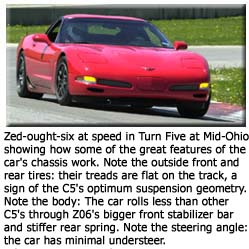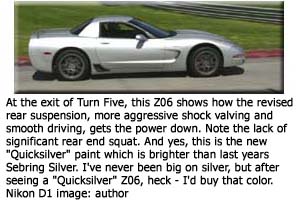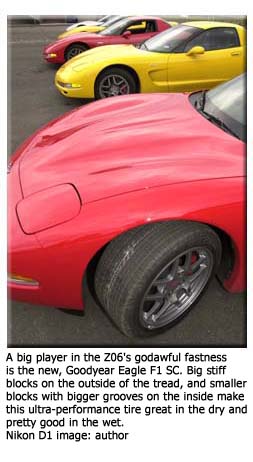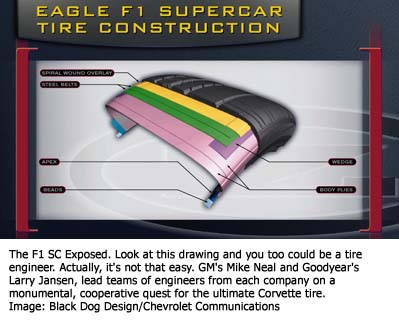 |
|
Page-2
2001 Corvette Z06 by Hib Halverson
Cutting Edge Handling
While such an improvement obviously required hardware
changes to the C5 suspension; no way could the Zed-ought-six be as good
as it is without three characteristics at the core of any í97-up
Corvetteís good ride-and-handling.
1) Stiff structure: backbone construction with
enclosed driveline tunnel and hydroformed outer frame rails make the carís
structure one of the stiffest in the world. Hardtops are the stiffest of
all C5s because they have both the Coupeís "top bow" and the
Convertibleís extra crossbar behind the seats. Bodywork behind the
windshield and above the belt line is bolted to the windshield header
and is bolted and bonded to the rear deck. The underbody structure, the
fixed roof and the lack of the big hole in the back for the Coupeís
hatch make the Hardtop about 12% stiffer in torsion than a Coupe with
its roof in place. Rocket scientists out there will be interested to
know the convertibleís first torsional frequency is 20hz. Coupes with
the roof out are at 20.5hz and, with the roof on, jump to 22hz. The Z06
is a stout, 24hz.
2) Optimum suspension geometry: to enhance lateral
acceleration, all four wheels have static negative camber. Camber change
and roll stiffness are such that the car handles comfortably in everyday
driving but, when driven hard, generates substantial lateral grip. Both
the front and rear suspensions have virtually zero toe change though 95%
of their vertical travel. They also have virtually no toe change under
tractive, impact or lateral loads.
3) Ride decoupled from handling: "ride"
bushings, which isolate fore/aft movement of the control arms, are soft
to reduce impact harshness, but "handling" bushings,
which isolate lateral movement of the arms, are hard to minimize
unwanted toe or camber changes during high lateral acceleration.

These properties give the basic suspension enough
ride-quality bandwidth that Z06ís roll stiffness can be racheted-up
past that of the Z51 Sport Suspension without making the ride
unbearable. Itís easy to make a car go around corners like it was on
rails, but itís hard to do that and still have the car ride
comfortably and be pleasurable in the non-limit situations typical of
everyday street driving. Thankfully, Team Corvette was pretty successful
in doing that.
The new chassis tuning, known collectively as the
"FE4, Z06 High Performance Suspension" begins with added front
roll stiffness via a higher-rate, front stabilizer bar. Its diameter is
1.181 in., up .055 in. from the 2000-í01 Z51 bar.
In back, to add roll stiffness and reduce
acceleration squat, there is a new rear spring having a rate 10% higher
than Z51. The rear jounce bumpers are half an inch shorter which
increases rear suspension travel a bit. In a limit handling situation,
upon exiting a turn, if the suspension bottoms through the combination
of body roll and torque application, the spring rate goes through the
roof. The sudden increase in rate causes a corresponding, sudden and
undesirable oversteer. On the Z06, a small rear spring
rate increase and slightly more rear travel
means it can get power down better exiting turns without resorting
to a much larger spring rate increase and
the penalty in ride that would bring.

As with Z51, Sachs shocks are used. Shock valving for Z06 changed in
three areas compared to Z51.
Damping of low velocity suspension movement typical
of body roll was increased at all four corners. Mike Neal said
adding low velocity damping
slows body roll, firms the ride a bit and improves
the front suspensionĻs response in transient maneuvers, such as
quick lane changes or
autocross chicanes.
At the rear only, high velocity damping
was changed, with compression damping actually decreasing (because of
the higher spring rate) and rebound damping increasing, to improve wheel
control.
While they are noticeable changes by themselves, the
FE4 pieces donít fully account for such a huge, improvement in
handling. Goodyear, the only-remaining, big American tire company, is
behind much of the Zed-ought-sixís affinity for godawful fast driving
through a new, ultra-performance radial tire developed especially for
this car. Goodyearís partnership with Corvette dates to 1978 and this
marks the fifth time itís developed a tire especially for Americaís
Sports Car. Called the "Eagle F1 SC" (for "Supercar"),
this new tire had the Eagle F1 Fiorano, some aggressive rubber Goodyear
builds as an original equipment tire for Ferrari, as its development
starting point. |
|

Autocrossers and road racers, breathe a sigh of relief.
The F1 SC is not a run-flat. The Z06 mandate: cutting edge handling,
required giving up the convenience of an Extended Mobility Tire (EMT)
because of its weight and other compromises necessary in an everyday tire
for other C5s. This is not to say EMT technology canít be used in a
killer tire, but it is to say run-flat state-of-the-art is not quite
there, yet.
Compared to the regular C5 tire, besides a lighter
casing, the F1 Supercar has a softer tread compound and an asymmetric
tread pattern having large, stiff blocks and less water channels on the
outside. When a radial tire is generating high lateral acceleration, the
outer half of the tread does most of the work. The stiffer that part of
the tire is, the more the tire will grip and the more predictable the
quality of that grip will be. Expectedly, the F1 SCís dry traction is a
substantial measure better than that of the F1 GS-EMT on other C5s. For a
tire to work in the wet, tread blocks need to be smaller and water
channels plentiful. The inside half of the F1 SCís tread meets that
criteria and provides wet traction that is acceptable but not quite as
good as that of the F1 GS-EMT. The F1 Supercar progressed far past the
Fiorano in both grip and treadwear. It also quieter and it looks better.
The last characteristic setting this new Goodyear apart from other
Corvette tires is size. Most C5s use P245/45ZR17s, front, and
P275/40ZR18s, rear. Z06es use, wider, 265/40ZR17s in front and 295/35ZR18s
in back. In summary, the Goodyear Eagle F1 SC is one kick-ass,
ultra-performance tire. It will be interesting to see how quickly Goodyear
makes it available on the replacement market in other Corvette sizes.
|
|

The Z06 tires are mounted on a set of ten-spoke,
forged, aluminum wheels, 9.5x17, front, and 10.5x17, rear. While they
accommodate the bigger tires and have a "macho" look, they arenít
real attractive. My guess is the Z06 wheel will be like the í97-í99
base wheel with a lot of people swapping them for better-looking,
aftermarket designs. GM sells a really great-looking, five-spoke, forged
wheel as an option on all í00s and í01 Coupes and Convertibles. Itís
too bad that great-looking, timeless style couldnít have been applied to
the Z06. Instead, the new 10-spoke seems destined for the same
hall-of-shame where the and í89 and í97 wheels are displayed.
Wheel alignment specifications are changed. Camber of
-0.75 degree, a whopping 200% increase over other C5s, is used at all four
wheels. Ultra-performance radials work best with static negative camber
so, the new spec. is to compliment the cutting-edge performance of the
Goodyears. According to Mike Neal, the more pliable sidewall of the F1 SC
allows that much negative camber without an adverse effect on tire
mileage.
The final handling upgrade is a revised Active Handling
system. "AH2" is a significant improvement in a system that was
already good. A full discussion of it requires space we donít have, but
the key changes are: sideslip angle rate control, rear brake stability
control, improved coordination with traction control and a change in the
procedure to enable "competitive mode."
Sideslip angle control means AH2 can now sense if the
driver is too slow to react or overreacting to vehicle dynamics during
transient maneuvers that exceed the carís limits. The revised Active
Handling enables just the right amount of differential braking to assist
in maintaining vehicle balance. AH2ís control over rear brake
intervention is more precise during high lateral acceleration combined
with light braking, such as a driver surprised by a decreasing radius
turn. AH2ís response to that situation is more seamless and predictable.
AH2 is better coordinated with traction control which uses either rear
brake intervention and engine torque limiting to control rear wheel spin.
Compared to AH1, the revised Active Handlingís use of traction control
is skewed more towards rear brakes than engine controls. The result is
less engine "sags" and better engine response after a traction
control incident. Lastly, the Active Handling software has been changed
such that "competitive mode" (Active Handling without traction
control) can be enabled while the vehicle is moving. Previously, you had
to come to a full stop.
The result of all these handling upgrades is the Z06ís
transient response improves noticeably over Z51. At the rear, the effect
of increased torque output in lower gears is well controlled making the
car easier to drive off the turns than past Corvettes. Z06 generates
impressive lateral acceleration, too. In skid pad testing during
development, it pulled 1.03g. Corvettes with stock suspensions have been
past 1g beforeĖChevroletís claim for the 1984 Z51 comes to mindĖbut
always with non-production alignment and shaved tires. Z06 is the first
stock Corvette to pull over 1g lateral acceleration with production
alignment and tires. Active Handling is now is less invasive and more
capable.
Mid-12s on 30 More Horsepower: Next |
 |
 |
|